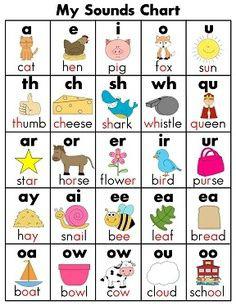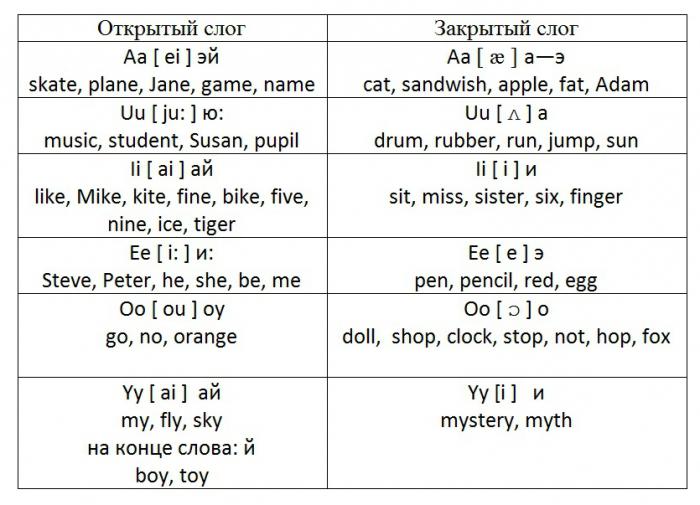Reading rules in English for beginners with examples
The first thing a person, a beginner,learning English - difficulty in reading most words. On this score, many jokes among even the speakers of this language, what to say about those for whom he is not native. One Dutch linguist even wrote a poem containing the most difficult and contradictory cases of English phonetics - it is difficult to read it without mistakes even to someone who knows the language well.
But jokes are jokes, but you have to learn how to pronouncewords are correct. This is helped by the rules of reading in English. For beginners they will be a bit complicated, but it's only with unaccustomed. Having understood them and having well established the theory on examples, you will see how much they will make your life easier for you.
What are these rules for?
Without knowing them, it will be difficult to learn to read. Of course, you can remember the transcription of those words that you meet. But in this case your ability to read will be very limited. And if you meet a word with a familiar root, but incomprehensible for reading the suffix or prefix? Or your own name? In such cases errors are inevitable, if you do not know the rules of reading in English. For beginners, they are especially important, because they allow you to feel and understand the logic of constructing the language at all levels, beginning with phonetics.

Next, you will learn how to read the variousSounds and their combinations, how to present the English rules to children and what exercises you can use to learn to read and remember the symbols of transcription.
Reading consonants
Let's start with the simplest, and then we willmove on to the complex. Most consonant sounds in the English language differ little from the Russians. But still the difference is felt. In general, we can distinguish such characteristic features:
- always firmly pronounced;
- sonorous sounds are not stunned at the ends of words;
- after the sounds [p, t, k] there is an aspiration, because lips open faster than in pronunciation in Russian;
- the sound [w] is pronounced distinctly, with two lips;
- when pronouncing the sound [v], on the contrary, only the lower lip is involved;
- many sounds [t, d, s, z, n, l, tʃ, dʒ] are pronounced with the tip of the tongue touching the alveoli, and not to the teeth (as in Russian pronunciation).
Reading vowels: 4 types of syllable
We continue to disassemble the reading rules in English. For beginners with examples it is better to submit material. Then it will be clearer how to pronounce this or that sound.
In the English alphabet there are only six vowels, but the difficulty of reading them is due to the presence of four different types of syllables:
- open;
- closed;
- vowel + r;
- vowel + r + vowel.
Consider them all in order, not forgetting the examples.

In the open syllable, the vowel is read as it isis called in the alphabet: O is read as "ou (eu)", U is read for a long "yu," etc. The exception is only the letter Y, which is pronounced "ay". How to determine that the syllable is open? It must end with a vowel that can stand:
- at the end of the monosyllabic word (me, go);
- in the beginning or in the middle (game, time, music);
- next to another vowel (suit).
In a closed syllable, which ends in a consonant (sometimes doubled), the vowels are read truncated:
- Aa [æ] turns into something between Russian sounds [a] and [e], for example: cat, apple.
- Uu [ʌ] is similar to the Russian sound [a], for example: rubber, jump.
- Ii [i] is read as a short Russian sound [and], for example: sit, finger.
- Ee [e] is read by the sound [e], for example: pen, egg.
- Oo [ɔ] is read by a short sound [o], for example: shop, fox.
- Yy [i] under stress must be read as a short sound [and], for example: mystery, myth.
This is the minimum that includes reading rules forEnglish for beginners. With exercises for all 4 types it is better not to rush, but first to learn the differences between closed and open syllables. Then you can go further, to more complex cases.
The type of the syllable "vowel + r" is read as follows:
- -ar pronounce with a long sound [aaa];
- -or is read as long [ooo];
- -ur, -ir, -er are similar to the sound [o], but only pronounced by the throat.
The type of the syllable "vowel + r + vowel" turns the sound into a special two-part phenomenon of English phonetics - diphthong:
- Aa is read [ɛə], an example: dare.
- Ee is read [iə], an example: mere.
- Ii is read [aiə], example: fire.
- Uu is read [juə], an example: cure.
- Yy is read [aiə], example: tyre.
The exception is the letter Oo, which in the fourth type of the syllable is not read by the diphthong, but simply by a long one [ɔ:]. For example: more.
Reading of letter combinations
Reading rules in English (for beginners and continuing study) can not do without explaining the various combinations of consonants and vowels. Let's start with the first.
The combination of wr at the beginning of the word: the sound [w] is not pronounced. Examples: write, wrist, wrong.
The combination of wh at the beginning of the word: the sound [h] is not pronounced. Examples: why, what, white. But there is an exception: if -wh is followed by the letter -o, the sound [w] is "dropped out" when reading. So the words: who, whole, Who and others sound.
In the letters kn and gn at the beginning of the word: only the sound [n] is read. Examples: knot, gnat.
The combination of ng at the end of the word sounds like a sound [ŋ], pronounced through the nose (going), and in the middle of the word - just [ŋg], for example: hungry, singer.
The combination of ch is read [tʃ], as the Russian sound [h '], soft. For example: cheese, coach.
The combination sh gives a sound [ʃ], similar to the Russian [w] in the soft version of the pronunciation. For example: she, push.

The combination of the letters qu is read [kw], for example: queen, quite.
The bland combination of -our is read [ə]: color, favorite.
The combination of -ous at the end of words should be read [əs]: dangerous, famous.
The combination of the letters -sion after the consonant is pronounced [ʃn], for example: mission. And after a vowel sound there is a ringing to [ʒn], an example: decision.
Before the letters e, i, y: the consonant C is pronounced with the sound [s], G is pronounced [dʒ]. In other cases it reads like this: C - [k], G - [g]. Compare: cell - cat, gym - game.
Vowel combinations: -ee, as well as -ea give a long sound [i:], the -ai combination is read [ai], the -oo combination gives the sound a long [u:]. For example: bee, seal, moon.
True, there are sometimes exceptions. For example, blood: in this word, the double O is read as a sound [ʌ]. But there are not many such cases. They are easy to remember, and they do not particularly complicate the rules of reading in English.

For beginners
For children and adults, the explanation of the rules will bedifferent. Young "Englishmen" will well learn the knowledge, if they are presented with elements of the game and fairy tales. For example, you can explain 1 and 2 types of reading as "open" and "closed" doors, where in the first case the letters feel free and scream their name (from the alphabet) loudly, and in the second - they are almost not audible. Similarly, you can compose a kind of grammar fairy tale and tell her child. An interactive element can be the task: "spell" the words, correctly reading them. It is much easier and more interesting to remember the rules of reading in English.
For primary school
The following small table includesthe rules of reading vowels in two types of syllables. For the convenience of a child who is new to transcription, next to the sound is placed about his reading, written in Russian letters. In any case, the table should be read aloud together with an adult who knows the language: one must pay attention to how the same letter behaves in different types of syllables, and to understand the proposed examples of words.

Primary school children are often asked to go homelearn transcription icons. You can make a set of cards and work out like this: you read a short word, where there is a certain sound, and the child shows a card with its designation. In group work, everyone should have their own set.
Read without hesitation
As soon as possible and better to rememberrules of reading in English? For beginners, exercises will be the best option. It's great if you manage to combine 2 types of classes: listen to samples and read independently. However, this approach may soon become boring, so it is good to connect the elements of the game and the competition. For example, take two different lists of words for various rules - one for you, another for a friend - and check who will read faster and with fewer errors. The game version can be this: using mixed cards with separate words and with transcription signs, find and lay out the matches.

Who needs reading rules in English? For beginners to study it (this goes without saying), for the continuer - to test yourself, and for the forgotten - to remember the knowledge that has not been used for a long time.
</ p>




